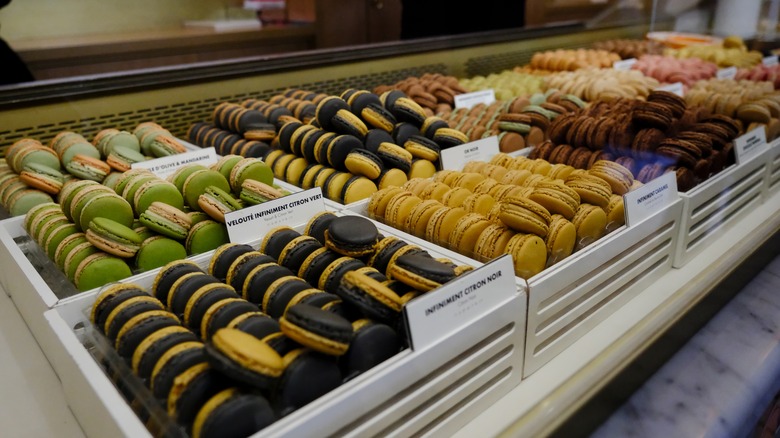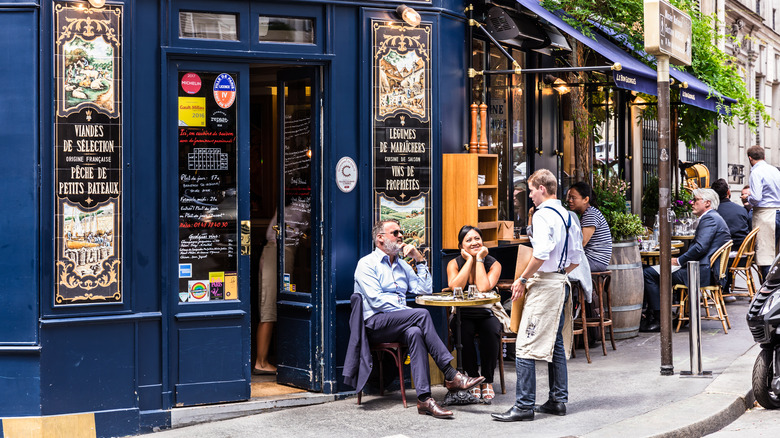The Popular European Country People With A Nut Allergy Will Have A Tough Time Visiting
Traveling with food allergies can be stressful at best and dangerous at worst — especially when the destination isn't known to accommodate dietary restrictions. Despite being one of the most visited countries in the world, France is one example. French cuisine — from the creamy cheeses to the decadent desserts — is a favorite among foodies, yet French restaurants and eateries aren't always welcoming places for people with nut allergies.
Nut allergies are rare in France and tend to be misunderstood by locals, including restaurant wait staff and chefs. One 2023 literature review noted that peanut allergies affect between 1 and 2% of the population in the U.S., the U.K., Canada, and Australia. Meanwhile, the rate is only between 0.3 and 0.7% in France. As a result, people in France may not take nut allergies seriously or truly understand the dangers associated with anaphylactic shock.
In some cases, this might mean being served food with nuts even after confirming that a menu item is free of such ingredients. This is what TikToker @zozomccormack claimed happened to her numerous times while in France. In other instances, you may be turned away from a restaurant entirely if they're unsure how to accommodate your allergy.
Foods to watch out for in France if you have a nut allergy
Unlike many other destinations, France isn't known for having a particularly nut-heavy cuisine. Still, nuts make an appearance in many classic French foods. For instance, French pastries, including tarts, cakes, and cookies, often rely on almond meal, an ingredient that isn't always easy to detect (until it's too late and you're reaching for your EpiPen, that is). Macaroons may also contain nuts, especially the traditional pistachio flavor. Another sweet treat to watch out for in France is crêpes, which may be filled with hazelnut spread. Even if you opt for a different flavor, there can still be a risk of cross-contamination at many crêperies.
Some savory dishes and non-dessert goodies in France also come with nuts. Pasta, salads, and bread may have nuts sprinkled on top or mixed into sauces, such as pesto. Local recipes like haricots verts amandine (green beans with almonds) also prominently feature nuts and won't be suitable for those with severe allergies. Be aware that cooking oils — namely peanut oil — may also contain allergens and are hidden in some French foods, as well as in non-French recipes served in other restaurants.
Navigating France as a tourist with a nut allergy
A nut allergy doesn't have to get in the way of your dream vacation to France. If you've been fantasizing about visiting the Eiffel Tower or strolling through the world-famous museums, there are ways to do so without going hungry — or being rushed to the emergency room. First, be prepared for the language barrier, especially if you hope to explore non-touristy areas. You don't need to learn a bunch of French before visiting France, but you should know how to communicate your dietary restrictions. One of the easiest ways to do this is by using an allergy card printed in French. These cards can be purchased online or printed for free from FoodAllergy.org.
Depending on what part of France you have your eyes set on, you may want to research allergy-friendly restaurants before your trip. In the tourist-packed neighborhoods of Paris, you might have an easier time finding an eatery that can accommodate nut allergies compared to small towns. Moreover, international chain restaurants found in big cities may work in a pinch if you're starving.
Finally, consider packing and buying your own food during your trip. Use a translation app to decode ingredient lists in the supermarkets, and keep some snacks in your bag, just in case. Booking a hotel with a kitchenette can also make it easier to prepare your own meals if needed.


